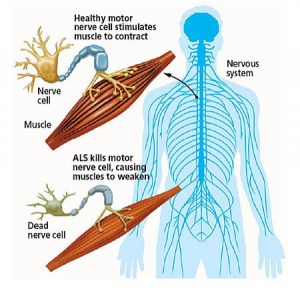Have you ever met someone with amyotrophic lateral sclerosis, better known as ALS? Do you know anything about it besides that it was the origins and reasons behind the “Ice Bucket Challenge”?
In 2014 the Ice Bucket Challenge was sweeping the Nation, everyone from celebrities to average individuals were challenging their friends to do this to raise not only money but awareness of this disease. Popular news sources and celebrities doing it the summer of 2014 seems to be what truly brought ALS to the knowledge of the general public. Today they use the month of August to focus on ALS via media and sources like the Ice Bucket Challenge.
However, you may have done it and not truly known what it is or where it comes from. It seemed that many didn’t know and few did their own research into the topic. General consensus seemed along the lines of ‘it is a debilitating disease that eventually steals all mobility from someone until they die.’
So then what is it?
According to the ALS association it was originally discovered in 1869 by a French neurologist, but it wasn’t until 1939 when it got national recognition by the diagnosis of baseball player Lou Gehrig. It is still commonly known today as Lou Gehrig’s disease. ALS is a progressive neurodegenerative disease affecting the motor neurons in the brain and spinal cord leading to their eventual death and therefore loss of mobility and eventual paralysis (see picture on the right). Most of the patients end up passing due to respiratory distress or failure because of these neurons.
in the brain and spinal cord leading to their eventual death and therefore loss of mobility and eventual paralysis (see picture on the right). Most of the patients end up passing due to respiratory distress or failure because of these neurons.
Most of the patients with ALS have a sporadic variation, sporadic ALS, rather than a genetic variation, or familial ALS. The familial ALS is exceedingly more rare than the sporadic. In the genetic variation, the age of onset is about 46, ten years younger than the sporadic form at 56. The only real difference between the two is the family history, otherwise they are clinically the same with mutations in the same gene. This gene is the SOD1 gene, responsible for generating the enzyme superoxide dismutase which breaks down oxidation. The SOD1 gene mutations causes a misfolding of proteins therefore unable to provide proper function.
So what happens when someone has ALS?
ALS develops in most people between the ages of 40 and 70, averaging around 55/56. It is 20% more common in men than women and your risk increases as you age. It will start with muscle weakness, progressively worsening, then atrophy or rigidity will likely start to occur. Basic tasks that require manual dexterity will become exceedingly difficult overtime. If it is initially affecting the legs it can lead to awkwardness when walking, tripping or stumbling more frequently. Some notice in their voice first with muscle spasms in the face and throat.
Because of some of these symptoms it is hard to differentiate between ALS and multiple sclerosis or MS in the beginning. Both are neuroinflammatory disorders that affect the muscles and ability to move the body due to attacks on the brain and spinal cord. MS however is more to do with the myelination surrounding the neurons.
Eventually people with ALS will sucumb to their disease either with respiratory failure/ distress or an additional illness they will not recover from. Some of the people with these illnesses actually die from morphine overdose in hospice facilities. It is not something commonly talked about but commonly is because the patient is given so much morphine to be kept comfortable that their organs start to shut down and they die.
The Neuroscience Behind It All:
Oxidation is a key component in ALS. Oxidative stress or damage is found to damage mitochondria, aggregate proteins, impair autophagy (cell death), and impair splicing proteins. Ultimately, this is a circular system between oxidative stress/ damage and FUS/ TDP4B. As stated prior oxidative stress leads to mitochondrial damage which in turn leads to the bad splicing of RNAs for the motor neurons. The Fus/TDP4B leads to oxidative stress and mitochondrial disfunction. TDP43 inhibits FOXO, a gene that tends to protect against oxidative damage, this causes a downregulation of mitochondrial proteins leading to oxidative damage. Mutations in the TDP43 gene changes the splicing location in Mtfr-1 which leads to mitochondrial fission. Lastly Fus activates PGC-1α which transcribes proteins, when Fus is not functioning correctly it can result in DNA damage, meaning more mutations. Overall this leads to problems.
ALS is a pretty scary condition for those whose lives are impacted by it. They are slowly losing themselves, becoming trapped inside their heads if they even last that long. This August join in with the Ice Bucket Challenge in helping to raise awareness and research funding for this terrible disease.